On 2 April 2022, the Russian army was forced to retreat from the vicinities of the Ukrainian capital. After more than a month of heavy fighting, Ukrainian defenders partially destroyed the invading force around Kyiv and pushed the Russians back to neighboring Belarus. What was supposed to be an overwhelming blitzkrieg became a complete debacle for the Russian forces.
The victory in the battle of Kyiv gave Ukrainians a big lift. It helped Western allies to believe that Ukraine could repel the Russian invasion and defend its independence despite all odds. This victory paved the way for substantial Western military aid that Ukraine desperately needed to liberate its territories from the Russian occupation.
It is safe to say today that the battle of Kyiv has changed everything for Ukraine. However, a year ago, no one in the world, except Ukrainians, would bet a dime that Ukraine could save Kyiv from the Russian onslaught.
Failed Russian blitzkrieg and fierce Ukrainian resistance
On day one of the full-scale invasion, Russian forces crossed the Ukrainian border from the east, north, and south, splitting their war effort into several axes of a rapid advance. In the south, Russia attacked the Kherson and Zaporizhzhia oblasts of Ukraine from the occupied Crimean Peninsula. In the east, Russian forces launched a large-scale offensive from the territory of Russia and the occupied Donbas region, attacking Kharkiv, Donetsk, and Luhansk oblasts. In the north, Russia started an assault on Sumy, Chernihiv, and Kyiv oblasts, using the territory of its ally Belarus to attack the Ukrainian capital Kyiv.
Russia had been building up its forces of 190 000 troops on the Ukrainian border since March 2021, planning to pull off an overwhelming blitzkrieg to capture Kyiv and other big Ukrainian cities quickly.
Russian logistics, which heavily relied on the railways, was prepared for a short war with minimum resistance from the Ukrainian people. Russian political and military leadership completely misjudged Ukraine, providing Russian troops that attacked the Ukrainian capital with parade uniforms to march down Kyiv’s downtown after a successful and fulminant offensive.
These miscalculations of the Russian leadership defined the course of the offensive that aimed to surround and capture Kyiv within a matter of days. Although the US intelligence officials were concerned that Kyiv might fall under Russian control within days, Ukrainians braced for heavy resistance. Ukraine’s Defense Minister Oleksii Reznikov recalls that western intelligence thought Ukraine would collapse rapidly and Kyiv would fall down within 72 hours.
“I saw personally a secret order from Russian commanders to their air assault troops that they have to control the government quarter in Kyiv within 12 hours,” Reznikov said in December 2022. He added that the order had been retrieved from a dead body of a Russian soldier on the outskirts of Kyiv.
In his interview with Radio Liberty on 23 February 2023, Joseph Borrell, the High Representative of the European Union for Foreign Affairs and Security Policy, said that no one expected that Ukraine would resist Russia so desperately, and Russian President Vladimir Putin was sure that he would be in Kyiv in a matter of weeks.
"No one expected that Ukraine would resist like this. No one. And Putin certainly did not expect it. Putin was sure that in a matter of weeks, he would be in Kyiv. And, of course, most of Ukraine's friends feared that Ukraine would not stand,” Borrell said. “But the Russian army has demonstrated that its military is not as skilled as it was supposed to be, instead, Ukrainians are much braver and ready to defend their state."
The key aim of the Russian offensive during the first phase of the full-scale invasion was highly likely to capture the Ukrainian capital, decapitate Ukraine’s leadership, and install a puppet government in Ukraine. The battle of Kyiv had to determine the further course of the war and the fate of the 40-million country.
Despite all odds and lack of confidence of the Ukrainian allies in the ability of Ukraine’s Armed Forces to prevent Russia from capturing Kyiv, Ukrainians did the impossible to defend their capital. The battle of Kyiv lasted from 24 February 2022 to 2 April 2022, when Russian forces retreated.
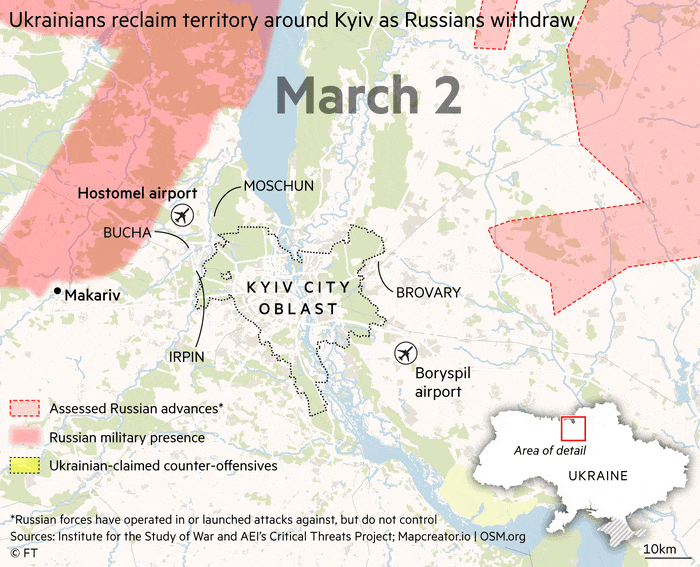
Russian attempts to capture airfields around Kyiv
On 24 February 2022, Russia launched a massive missile attack on Ukraine, targeting air defense systems, airfields, military bases, and critical infrastructure to paralyze Ukrainian defensive capabilities. The second step of the Russian military command came shortly with the rapid advance of the land forces inside Ukraine combined with airborne operations. The air assaults aimed to capture key objects and government buildings in the biggest cities, such as Kyiv, the second-largest city of Ukraine, Kharkiv, and the Black Sea port Odesa. Russian forces planned to use helicopters, large Il-76 planes, and a naval landing force to reach their objectives.
The Russian operation to capture the Ukrainian capital involved several hundred paratroopers deployed to Hostomel (the airfield some 30 kilometers northwest of Kyiv) on 24 Mi-8 transport helicopters accompanied by ten large helicopter gunships Mi-24, Ka-52 combat helicopters and 12 fighter jets.
Russians planned to turn Hostomel into a military base and huge logistics hub to receive large Il-76 transport aircraft that would deploy the main forces of the airborne operation to occupy Kyiv. If Hostomel fell under Russia’s control, Russian forces could airlift more troops and heavy weaponry within hours. Such a scenario would have allowed the Russian army to amass forces close to Kyiv and break into the Ukrainian capital.
Russian Airborne Forces made an air assault on Hostomel
international cargo airport early in the morning, on 24 February, just a few hours after Putin’s televised war declaration.
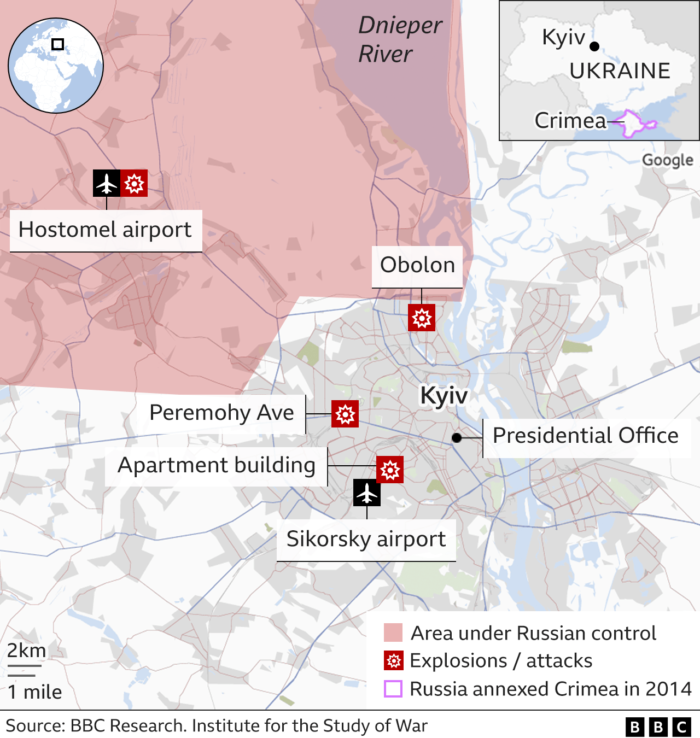
Around 300 Ukrainian defenders, mainly inexperienced draftees, were stationed at Hostomel airport to defend it. After a soldier of the Ukrainian National Guard, Serhiy Falatyuk, shot down a Russian helicopter with a MANPAD, the spirits of his comrades soared. As the fighting continued, the Ukrainian air defense became more effective, making it harder for Russian aircraft to approach the Hostomel airfield. Ukrainian forces downed several Russian transport and combat aircraft.
After hours of intense fighting, the regular Ukrainian Army combined with the National Guard and Territorial Defense units (the military reserve component of Ukraine’s Armed Forces created just a month before the invasion) pulled off a successful counter-attack, encircled Russian paratroopers that landed at the airfield and repelled the assault on 24 February.
Russian attack on Hostomel resumed on 25 February. Another air assault by Russian Airborne Forces was supported by armored reinforcements coming from the territory of Belarus. After Russian land forces crossed the Ukrainian-Belarusian border early in the morning on 24 February, they captured the Chornobyl nuclear power plant and the exclusion zone around it some 130 kilometers from Kyiv.
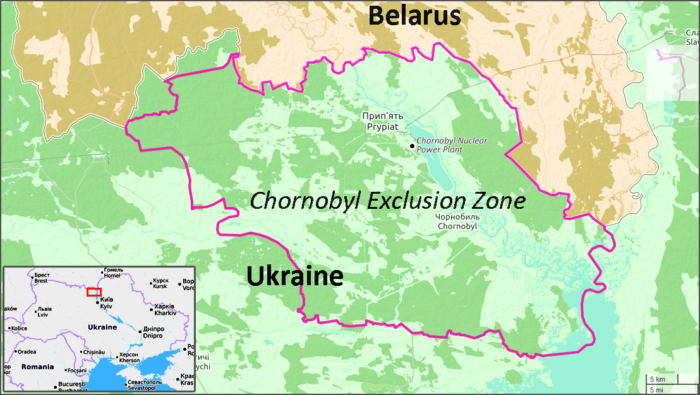
Breaking through the Ukrainian defenses in the Chornobyl area allowed Russian forces to support the airborne operation against Hostomel on 25 February. Although the Russian army managed to capture the airport in Hostomel and occupy the entire city, the airfield was damaged during the battle and could not be used as a functional airstrip. Sadly, a Ukrainian cargo airplane An-225 Mriya, the world's largest aircraft, was destroyed in its hangar during the battle of Hostomel.
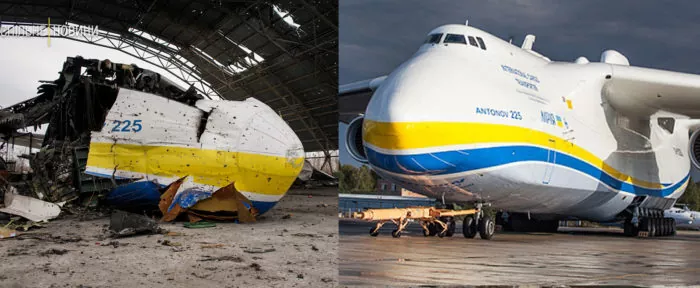
On 26 February, early in the morning, Russian paratroopers landed in the city of Vasylkiv (some 40 kilometers south of Kyiv) to capture the Vasylkiv air base. On 26 February, Ukraine’s officials reported that the Ukrainian Su-27 fighter jet shot down the Russian strategic airlifter Il-76 that was carrying Russian paratroopers. Another Russian Il-76 was allegedly shot down by Ukrainian defenders near the city of Bila Tserkva in Kyiv Oblast on the same day. The attack of the Russian Airborne Forces on Vasylkiv was repelled.
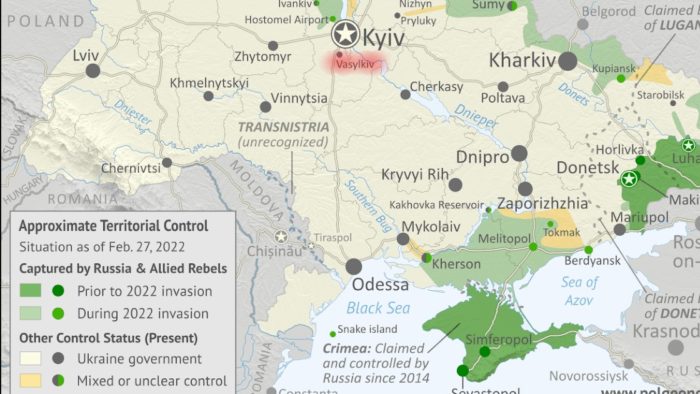
Map by Political Geography Now.
Multilayered defense
Despite the occupation of Hostomel and further advance towards Kyiv from the northwest, stiff resistance from Ukrainian forces managed to halt the Russian offensive and won some time, allowing the Ukrainian Army to redeploy reinforcements and strengthen the defense of Ukraine’s capital.
Considering that the main Ukrainian forces were deployed to the Donbas region in eastern Ukraine, the greatest defense burden around Kyiv fell on the shoulders of the Ukrainian 72nd Mechanized Brigade stationed in Bila Tserkva (the largest city of Kyiv Oblast, 85 kilometers southwest of Kyiv).
General Colonel of the Ukrainian Armed Forces Oleksandr Syrskyy, who was in charge of the defense of Kyiv, had analyzed the possibility of the Russian attack on the Ukrainian capital and determined that Russian forces would advance Kyiv using three major highways. Two of those roads led from Belarus into the Chernihiv Oblast and down to Kyiv from the eastern bank of the Dnipro River.
Kyiv, a city of three million people, is split in half by the Dnipro River, with the government quarter located on the hills of the western bank of the river. Considering that the Russian objective was to decapitate Ukrainian leadership, the fastest way to the government quarter was from the northwestern suburbs of Kyiv, such as Hostomel, Bucha, and Irpin.
General Syrskyy organized two layers of defense to protect Kyiv: one in the Ukrainian capital's suburban area and another in Kyiv itself. The Russian plan assumed disoriented forces would defend the Ukrainian capital while Ukraine’s political leadership, including President Volodymyr Zelenskyy, would flee the city.
However, the Ukrainian President and government decided to stay in Kyiv despite the danger and refused to relocate to western Ukraine, which boosted the morale of Ukrainian defenders. Thousands of people in Kyiv and all over Ukraine joined the Territorial Defense units and the Armed Forces of Ukraine to defend their homes.
On top of that, the landscape around Kyiv made it hard for Russian forces to advance. The Ukrainian capital is surrounded by forests, rivers, and urban areas that turned into strongholds of resistance and narrow roads leading to Kyiv amid muddy fields that Russian tanks and armored vehicles could not use to detour during the upcoming spring thaw.
Although Russian forces achieved some success in the northwestern outskirts of Kyiv and managed to occupy Hostomel on the second day of the invasion and Bucha (some 30 kilometers from Kyiv) on 27 February, the Russian advance towards the Ukrainian capital from Chernihiv and Sumy oblasts on the eastern bank of the Dnipro River was halted by the Ukrainian forces.
The advance of the multi-kilometer column of Russian armored vehicles that were moving toward Kyiv from the territory of Belarus also stalled. According to the satellite image by Maxar Technologies, on 1 March 2022, the Russian column was more than 55 kilometers long. The column was dispersed to avoid stinging attacks from Ukrainian mobile units that actively employed hit-and-run tactics using anti-tank weapons, such as Ukrainian-made Stuhna, American-made Javelin, and British-Swedish NLAW. Part of this column was destroyed, while another part managed to reach the vicinities of Kyiv, namely Hostomel, Dymer, and Moshchun.
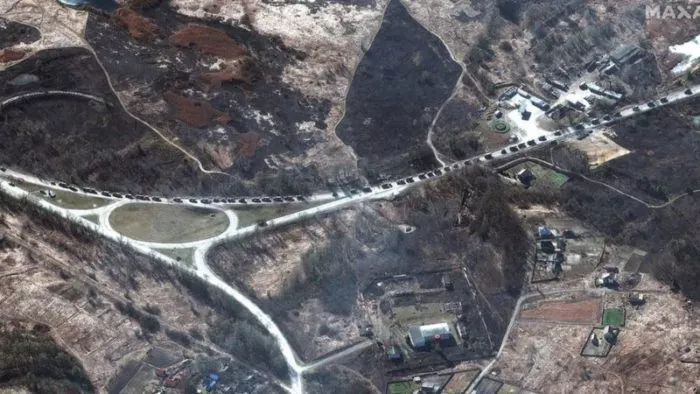
Russian saboteur groups inside Kyiv
Although Russian saboteur groups were operating inside the Ukrainian capital, Russian invading forces around Kyiv did not have enough resources to benefit from such activity. On the morning of 25 February, Russian saboteurs
dressed as Ukrainian soldiers entered the northwestern neighborhood of Kyiv, Obolon District (some ten kilometers from downtown Kyiv). Ukrainian forces killed the saboteurs. Throughout the day, gunfire was heard in several neighborhoods of the Ukrainian capital. The clashes with Russian saboteurs inside Kyiv continued into the night.
The Mayor of Kyiv Vitalii Klitschko imposed a curfew in the Ukrainian capital to make it easier for Ukrainian forces to track down Russian saboteurs. Clashes between Ukrainian defenders and Russian saboteur groups continued inside Kyiv during the first week of the invasion. Ukraine’s President Volodymyr Zelenskyy urged residents of Kyiv to prepare for the Russian assault and used everything they had at hand, from rifles to Molotov cocktails.
Ukrainian authorities provided citizens with around 18 000 firearms during the first day of the Russian invasion alone.
On 26 February, Ukraine’s Interior Minister Denys Monastyrskyy announced that residents of Kyiv were given more than 25 000 assault rifles, around 10 million rounds, and rocket-propelled grenades.
Stinging attacks on Russian logistics
One week after Russia’s invasion of Ukraine began, Kyiv stood strong despite the danger of being encircled by the Russian army. Russian forces started to face a lack of ammunition, fuel, and food supplies, while their lines of communication were constantly under attack. All key railway junctions and big Ukrainian cities in northern Ukraine, such as Chernihiv and Sumy, remained under the control of Ukrainian forces, which paralyzed Russian overstretched supply lines.
While Ukrainian forces in Sumy and Chernihiv crippled Russian advance towards Kyiv with stinging attacks, unarmed locals used social media to report the movement of Russian forces along the highways and through their towns and cities, giving valuable information to Ukraine’s Armed Forces. Ukrainian IT volunteers created chatbots to help people report Russian movements in a fast and effective way.
Unable to occupy the big Ukrainian cities of Chernihiv (144 kilometers northeast of Kyiv) and Sumy (330 kilometers east of Kyiv), Russian forces had to leave these pockets of resistance in their rear, trying to advance towards Kyiv as fast as possible. Such an approach made Russian supply lines vulnerable to attacks from Ukrainian partisans and Special Operations Forces in Chernihiv, Sumy, and Kyiv oblasts. On the way to Kyiv, Ukrainians ambushed Russian military columns and inflicted heavy losses on Russian forces that aimed to encircle the Ukrainian capital.
Evolution of Russian tactics in Ukraine: From failed blitzkrieg to assault infantry
Small Ukrainian military units maneuvered around the Russian ground lines of communications (GLOCs), hitting Russian forces with anti-tank weapons like Javelins and NLAWs. While Ukrainian artillery used shoot-and-scout tactics to pound at Russian forces, Ukrainian drone operators skillfully used Turkish-made armed drones Bayraktar TB-2 to burn down Russian tanks, infantry fighting vehicles, and artillery systems from the air. In fact, during the first weeks of the Russian invasion, the effectiveness of Bayraktar drones turned these unmanned aerial vehicles into the symbol of Ukrainian resistance, with songs being composed about them.
As the Russian blitzkrieg around Kyiv got bogged down in stiff resistance from the Ukrainian people, a joke about Russian military capabilities started circulating amid Ukrainians: “Russia has the world’s second most powerful army, the first being the Territorial Defense unit of Sumy city.” Such jokes demonstrated how high the morale of Ukrainians was in the face of the relentless Russian invasion.
Kyiv on the brink of falling
The Ukrainians skillfully used natural obstacles, such as the Irpin River northwest of Kyiv, to halt the Russian forces' creeping advance toward Ukraine's capital. The artillery of Ukraine's Armed Forces stationed in the northern vicinities of Kyiv worked day and night to prevent Russian forces from crossing the Irpin River, which would have opened the way to the Ukrainian capital for the invaders.
Despite fierce Ukrainian resistance, Russian forces took control of the northwestern Kyiv suburbs and started to regroup to resume the onslaught and break the defense of Ukraine's capital city. During the rapid advance of the first week of Russia's full-scale invasion, Russian troops took control of Chornobyl, Ivankiv, Dymer, Borodyanka, Hostomel, and Bucha.
The urban combat inside Irpin, the northwestern suburb less than ten kilometers from Kyiv, slowed down the Russian advance that bumped into the natural stumbling block, namely the Irpin River. The Ukrainians blew off all the bridges across the Irpin River that the Russian army could use to enter Kyiv. Having failed to break through Ukrainian defenses in Irpin, Russian forces prioritized advancing on Kyiv from another direction.
On 5 March 2022, Russian special forces managed to cross the Irpin River and enter the northwestern part of Moshchun, a small village three kilometers northwest of Kyiv.
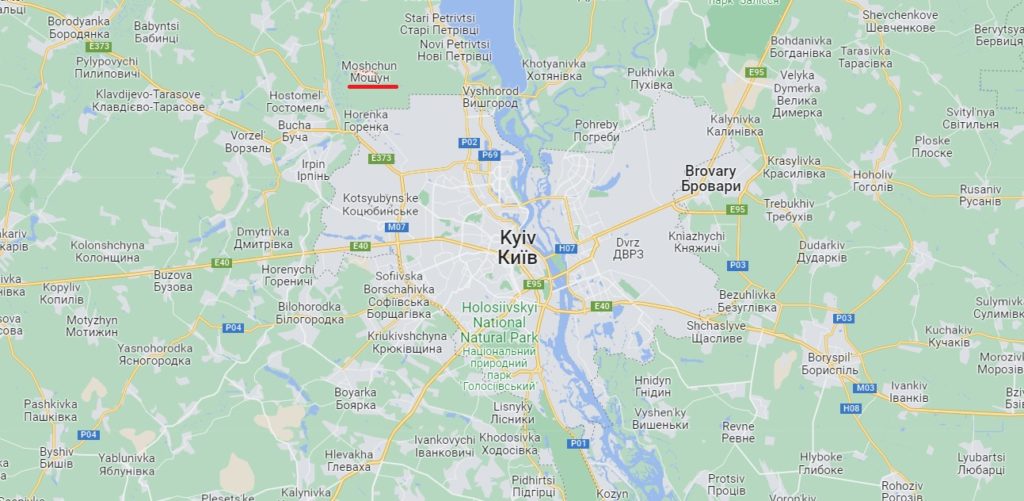
Although Ukrainian artillery constantly targeted the pontoon bridges of the Russian forces, the Ukrainians failed to prevent the enemy from gaining a foothold in Moshchun. Russian forces began transporting the reinforcement across the Irpin River. Under pressure, the company of the 72nd Mechanized Brigade of Ukraine's Armed Forces led by captain Roman Kovalenko retreated
to the center of the village and regrouped. Ukrainian special forces and territorial defense armed with anti-tank weapons arrived as reinforcements.
The Russians continued to advance, attacking Ukrainian forces in and around Moshchun with multiple rocket launchers, heavy artillery, airstrikes, armed drones, and attack helicopters. On top of that, Russian forces disabled Ukrainian communications, as well as reconnaissance and armed drones in the area, using electronic warfare equipment.
Russian military command clearly saw Moshchun as a gateway to Kyiv. Winning the battle for this important defense outpost of the Ukrainian capital would have allowed the Russians to advance and begin the urban combat inside the city of Kyiv.
Thus, the Ukrainian command could not afford to let Russian forces secure the bridgehead in Moshchun. Russian advantage in artillery, fighting vehicles, and tanks in this area was extremely hard for the Ukrainian forces to deal with. Ukrainian defenders needed to think outside the box and devise extraordinary measures to stop Russian advance. Ukraine's Armed Forces command had to act fast to find a solution and save Kyiv.
On 8 March 2022, Ukrainian special forces penetrated into the Russian-occupied Dymer, 30 kilometers north of Kyiv. The Ukrainians blew up the dam at the mouth of the Irpin River to increase the water flow into the river and create boggy terrain on the banks. As a result, a few days later, the flooding exceeded the banks of the Irpin River by two meters and washed away all Russian pontoon bridges. It became nearly impossible for the Russian manpower and armored vehicles to cross the natural barrier and reinforce the Russian grouping in Moshchun.
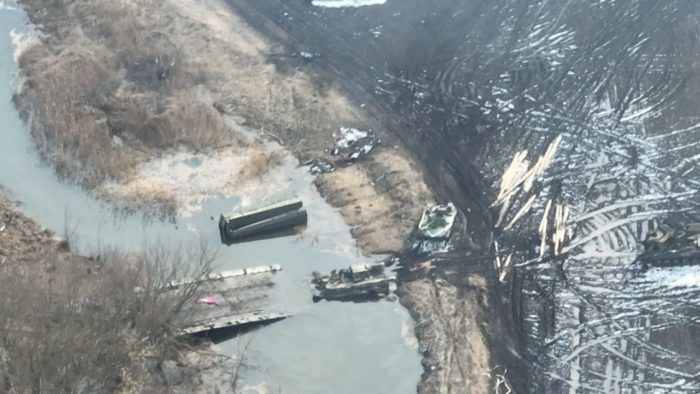
Credit: Ukrainian Ground Forces.
However, the situation for the Ukrainian defenders inside Moshchun was already extremely difficult. Under the influence of heavy artillery fire, Ukrainian forces had to retreat gradually over the following days and set up defensive positions in the forest near Moshchun.
Around 14 March 2022, Oleksandr Vdovychenko, the commander of the 72nd Mechanized Brigade, offered to the Commander-in-Chief of Ukraine's Armed Forces, General Valerii Zaluzhnyi, to retreat from the area near Moshchun. The General replied by saying, "If you move away, then Kyiv may fall," and "We will look for forces and means."
Ukrainian defenders were running critically low on 152-mm artillery shells. Russia reportedly had a 20:1 artillery advantage in the Kyiv Oblast.
However, the deployment of Ukrainian reinforcements (such as the 80th Air Assault Brigade) helped offset the advantage of the Russian army. Simultaneously with the beginning of the counteroffensive of the Ukrainian troops in Irpin and Bucha, the mobile units of Ukrainian forces started counterattacking the Russian grouping in and around Moshchun.
Eventually, Ukrainian forces surrounded Moshchun from two sides. Ukrainian artillery began to shell the Russian concentrations of manpower and armored vehicles heavily. Despite the heavy losses, the Ukrainian army pushed Russian troops back to the Irpin River. Thus, the Ukrainians liberated Moshchun from the temporary occupation, eliminating the threat of the Russian advance inside the city of Kyiv.
Russian retreat
The weather in late February and early March of 2022 was quite warm, which benefited Ukrainian defenders. The snow started to melt. The muddy soil made it difficult for the Russian armored vehicles to move anywhere but on the roads.
On 10 March 2022, the Ukrainian battalion of the 72nd Brigade ambushed a Russian tank convoy moving from Zalissya (38 kilometers from Kyiv) towards Brovary, the northeastern suburb of Kyiv (25 kilometers from the Ukrainian capital). Locals and Ukrainian reconnaissance groups reported the movement of the Russian tank convoy. When Russian tanks approached the small village of Skybyn (32 kilometers northeast of Kyiv), Ukrainian troops hit the first tank of the convoy with an anti-tank weapon NLAW, which wreaked havoc amid Russian troops. Russian tanks moved onto the muddy side of the road and became easy targets for Ukrainians. As a result, the Russians had to retreat, leaving 17 tanks and three armored vehicles on the battlefield. It was one of the most painful defeats of the Russian army on the way to Kyiv. On 19 March, Russian forces made another attempt to capture Brovary, but their assault was repelled.
Russian advance on Kyiv from the northwestern and western suburbs of Kyiv stalled. Due to a lack of reinforcements and weak control over the supply routes, Russian forces started to retreat from the vicinities of Kyiv in late March. On 2 April, the Ukrainian Ministry of Defense announced that Russian troops withdrew from the entire Kyiv Oblast.
Thus, at the beginning of April, Ukrainian forces retook the North. Russian forces retreated from Kyiv, Chernihiv, and Sumy oblasts. The heroism of soldiers and the wit of Ukrainian commanders saved the Ukrainian capital from the threat of being encircled by the superior Russian forces. Undercut by poor logistics and tactical failures, the Russian army suffered heavy losses trying to break through the Ukrainian defense and was forced to admit the defeat. Russian blitzkrieg failed.
Ukraine won the battle of Kyiv and entered a new chapter of the war: the battle of Donbas. The war of attrition began. Ukrainian courage and resilience saved the citadel of Ukraine's statehood. The triumph in the battle of Kyiv completely turned the tide of the war, boosting the morale of the Ukrainian people and giving hope for overall victory.
Related:
- One year of Russia’s war: from battle of Kyiv to battle of Bakhmut
- Ukraine to liberate Crimea by end of August 2023 - Ben Hodges
- What if Russia strikes Ukraine with nuclear weapons? Lawrence Freedman explains

